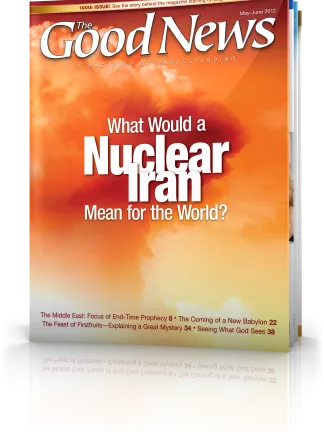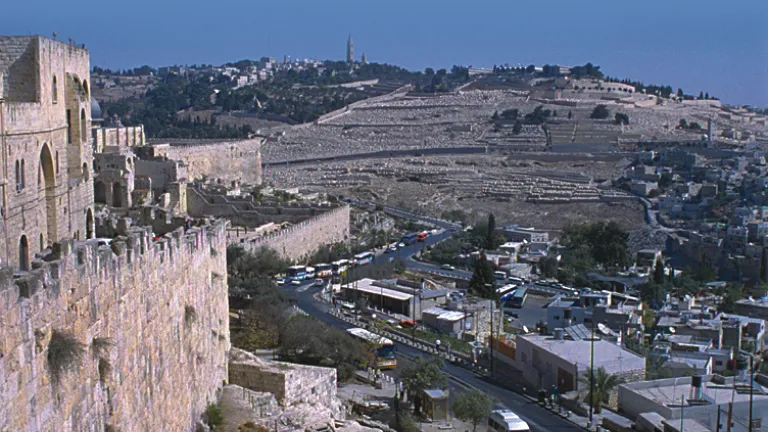The Middle East: Focus of End-Time Prophecy

We often see the Middle East catapulted to the forefront of news programs around the world. Even faraway nations are deeply affected by what happens in this volatile region. You need to understand what has been prophesied to occur there and why.
The bloody civil war in Syria and the threat of war between Iran and Israel have rightfully heightened awareness of the fragility of peace in our world, and in particular the Middle East. Events in this historic land are destined to affect the lives of everyone on earth.
Before World War I (1914-1918) the Middle East was dominated by the Turkish Ottoman Empire, which enforced a level of peace throughout the region. This vast conglomerate included territories of the modern states of Turkey, Egypt, Saudi Arabia, Lebanon, Syria, Iraq, Kuwait, Jordan and Israel. At one time this empire presided over extensive lands in both North Africa and Southeast Europe.
The Turkish Empire might have continued were it not for World War I. Early on it wasn't clear which side the Ottomans would support. Both the British and the Germans sought the Sultan's support. But ultimately he decided to back Germany, a fatal decision that led to the birth of many new nations—and seemingly wars without end.
Let's look at the astounding historical and end-time story of this crucial region, laid out millennia ago in the Bible. In projecting forward through these end-time events, we'll see the crescendo building toward the time of Armageddon.
A coming superpower
Events in Europe and the Middle East will affect the entire world, and at the outset we should all realize that we are now in transition between this age of man and a wholly different utopian world to come. But mankind will make a last-ditch attempt to establish a global power, apart from God, just before Jesus Christ returns to establish the Kingdom of God and begin His benevolent divine rule on planet Earth.
Just a few years before He returns, bringing His coming government to be headquartered in Jerusalem, a powerful kingdom of men will arise—a stunning superpower with roots in the ancient Holy Roman Empire.
This rise of a final mighty kingdom of men will constitute the last resurrection of a long series of attempts to establish a European-centered superstate dating back to the time after the fall of Rome in A.D. 476. It will mark the final futile effort of deceitful and rebellious men to establish their version of peace on earth apart from the Creator God.
Jerusalem's crucial background
Today the state of Israel is surrounded by hostile nations that wish to bring its existence to an end. The Bible long ago foretold this would happen (see Psalm 83:3-5). To understand where events are heading, you need to understand something of Israel's historic and prophetic background.
In the Bible the name Jerusalem not only stands for the geographical city itself, but is often used symbolically for the peoples of Israel as a whole. This historic capital remains the most contested city on earth, having fallen to invading forces more than 20 times throughout its recorded history.
The territory on which the state of Israel, including Jerusalem, sits was once ancient Canaan, the land to which God sent the patriarch Abraham some 4,000 years ago. It lies at the crossroads of three continents—Asia, Africa and Europe. And of course the Holy Land is considered sacred by three world religions—Judaism, Christianity and Islam.
More than 2,500 years ago, God revealed to the prophet Daniel that the land of His people would be fought over throughout the coming centuries. To understand the global implications, we need to examine Daniel 11, the Bible's longest continuous prophecy, which covers events in the region from Daniel's day up to the coming return of Jesus Christ.
The first 35 verses of Daniel 11 give us the historic background and constitute an accurate, detailed account of what would befall the people of Judah in the Holy Land in the centuries following. The prophecy foretold that they would be caught up in a conflict between the Ptolemaic dynasty of Egypt to the south of Judah and the Seleucids of Syria to the north.
The rulers of these kingdoms were descended from two of the four generals who divided the Greco-Macedonian Empire after the death of Alexander the Great, whose exploits were foretold earlier in the book of Daniel. These two generals were the original "king of the North" and "king of the South" mentioned in Daniel 11—followed by later prophesied rulers who assumed control of these regions. You can read about the historical fulfillment of the first 35 verses of Daniel 11 in our free Bible study aid booklet The Middle East in Bible Prophecy.
Verses 36 through 39 suddenly fast forward in time. These passages are not only historic but also prophetic for our time. Verse 40 makes a clear jump to "the time of the end," as we will see.
The time of the end
Who was this king of the North during the period just before Jesus Christ was born into the world? In 65 B.C. Seleucid Syria was swallowed by the Roman Empire. In effect that empire became the kingdom of the North. This is the key historical transition that enables us to understand how this prophecy applies to the time of the end. Thereafter the king of the North referred no longer to the Seleucids of Syria, but to the rulers of the Roman Empire and their successors.
Daniel 11:36-38 describes the actions of the Roman emperors and their successors, leading down through time all the way to the final charismatic leader of the end time.
Now read Daniel 11:40: "At the time of the end the king of the South shall attack him; and the king of the North shall come against him like a whirlwind, with chariots, horsemen, and with many ships; and he shall enter the countries, overwhelm them, and pass through" (emphasis added throughout).
This refers to events still to come. Clearly another outbreak of the age-old conflict will yet engulf the Middle East in modern times. But the conclusion will be quite different from anything that has happened before, because these events will lead directly to Armageddon and the second coming of Jesus Christ.
This crucial end-time conflict will center on Jerusalem and the Holy Land, the historic real estate God gave to the children of Israel through Abraham, Moses, Joshua and King David. "Thus says the Lord God: ‘This is Jerusalem; I have set her in the midst of the nations and the countries all around her'" (Ezekiel 5:5). Recall that the Holy Land is at the crossroads of three continents. This description is both symbolic and in its biblical sense geographic.
The final kings referred to in Daniel 11 are powerful geopolitical rulers who will come from both the north and the south, with forces trampling all over the present state of Israel and the Jewish people.
Revelation complements Daniel
At the time of the end, we see in the prophetic biblical books of Daniel and Revelation that a new global superpower will arise. We discover further details of this end-time power in Revelation 17. Just as the prophet Daniel saw various beasts that represented dominant powers that would arise after him, so the apostle John saw a vision of a prophetic beast power that would dominate the world as the end of this age of man under Satan's influence draws ever closer.
"So he [an angel] carried me away in the Spirit into the wilderness. And I saw a woman sitting on a scarlet beast which was full of names of blasphemy, having seven heads and ten horns" (Revelation 17:3).
The revealing angel explained to the apostle John the meaning of the seven horns: "The ten horns which you saw are ten kings who have received no kingdom as yet, but they receive authority for one hour [a relatively short time] as kings with the beast. These are of one mind, and they will give their power and authority to the beast" (verses 12-13).
Notice that the next verse reveals that the time setting is the second coming of Jesus Christ: "These will make war with the Lamb, and the Lamb will overcome them, for He is Lord of lords and King of kings, and those who are with Him [the resurrected saints] are called, chosen and faithful" (verse 14).
Four dominating world empires
The beast referred to in Revelation 17 constitutes another view of the last of the four great empires of Daniel 7.
During his time in Babylon, Daniel recorded a vision of "four great beasts" (Daniel 7:3). These gentile empires would dominate the Middle East and have a major impact on the region. These dominant empires were, in chronological order, Nebuchadnezzar's Babylonian Empire, the Medo-Persian Empire, the Greco-Macedonian Empire of Alexander the Great and finally the Roman Empire.
Attempts made over the centuries to revive the power and might of the Roman Empire are prophesied to culminate in the revival of the end time. The final successor empire will strive, as others have, to restore the European unity Rome achieved more than 2,000 years ago.
It will once again become a powerful, dictatorial system in alliance with and supported by a great false church, depicted in Bible prophecy as a beast with horns of a lamb but speaking like a dragon and as a rich and powerful prostitute having immoral relations with world leaders (see Revelation 13:11-12; Revelation 17:1-7).
The fourth beast of Daniel
Since the fourth beast described in Daniel 7 exists at the time of Christ's return, as does the beast power John saw in Revelation 17, both prophecies dovetail—speaking ultimately of the same end-time resurrection of the Roman Empire.
It is true that the original Roman Empire fell centuries ago. But few realize that European leaders such as the Emperor Justinian, Charlemagne, Otto the Great, Charles V, Napoleon, Benito Mussolini and Adolf Hitler all tried to revive the Roman Empire in various forms over the centuries. One final revival yet remains.
The final resurrection, like the earlier Holy Roman Empire, will be centered in Central Europe. It appears that the European Union (EU)—though now experiencing major difficulties within its eurozone (the group of countries using the euro as common currency)—may possibly be its beginning in embryonic form.
That is not to say that all the current EU nations will be a part of the final configuration. It will be an alliance of the 10 "kings"—leaders of nations or regions—referred to above. They will combine to form a powerful military force that will directly involve itself in the Middle East.
This end-time king of the North spoken of in Daniel 11 certainly appears to refer to the final ruler of this European-centered superpower. But to understand who the king of the South might be, we should first briefly review the history and thinking of the peoples of the Arab world.
Understanding the Arab world
The Arab peoples are largely descended from Ishmael (a son of the biblical patriarch Abraham). They have long dreamed of unity. The warring tribes of Arabia were initially united by Muhammad through a new religion called Islam. A united Ummah, or worldwide community of Islamic believers, has been a constant dream down through the centuries. Yet unity has eluded the Arabs for the last 750 years. Only in the last 50 years have they been independent of foreign control.
A fundamental aspect of Islamic teaching is that Islam must become the dominant religion of the entire world. Several attempts have been made to bring about Arab unity. Sudan's Muhammad Ahmad ibn al-Sayyid (1844-1885) proclaimed himself the Islamic messiah, the Mahdi or divinely "guided one" chosen to unite Muslims and defeat the infidel. He ultimately failed to achieve this mission but had greater success than secular leaders have had.
Then Egypt's President Gamal Abdel Nasser (1956-1970) formed the short-lived union with Syria called the United Arab Republic (1958-1961). Saddam Hussein of Iraq imagined himself to be another Saladin (1138-1193, Muslim leader during the Crusades) and sought to unite the Arab world against Israel and the United States. But American military power brought his downfall and death. Even Osama bin Laden achieved considerable success in uniting many Muslims against America and the West, but he was eventually driven into hiding, found and killed.
Yet many Muslims still believe that another Mahdi is prophesied to appear during a coming time of tumult to ensure Islam's final victory over all other religions. Currently the Iranian President Mahmoud Ahmadinejad and his cohorts would desperately like to bring about the appearance of the final Mahdi to accelerate end-time events, as he sees them.
Of course, Scripture remains the ultimate guide in helping us to understand the real significance of these historic events and what they portend for the future.
Identifying the king of the South
As noted earlier, the initial mention of the king of the South in Daniel 11 referred to the Ptolemaic dynasty in Egypt. However, the prophecy later shows us that an end-time king of the South will rise up to challenge an end-time king of the North. And in doing so, this southern ruler will unwittingly set in motion a cascade of events leading to unimaginable carnage before Jesus Christ returns to the earth and stops the human race from being wiped out (see Matthew 24:21-22).
Notice again Daniel 11:40, a crucial passage bringing needed perspective to these climactic events: "At the time of the end the king of the South shall attack ["push at," King James Version] him, and the king of the North shall come against him like a whirlwind . . . and he shall enter the countries, overwhelm them, and pass through."
The end-time power from the South will provoke the northern ruler into launching a major military invasion into Egypt (verse 42). After this time, the king of the South is no longer a factor in Bible prophecy. Clearly this invasion by the European-centered Beast power will prove decisively victorious as he even brings forces into Israel.
Note verses 41-43: "He shall enter the Glorious Land [the Holy Land], and many countries shall be overthrown . . . He shall stretch out his hand against the countries, and the land of Egypt shall not escape. He shall have power . . . over all the precious things of Egypt; also the Libyans and Ethiopians shall follow at his heals." This military invasion and occupation extends from Israel into North Africa.
"But news from the east and from the north shall trouble him" (verse 44). This passage appears to be a reference to a massive army described in Revelation 9 that will challenge the king of the North.
The "kings from the east"
How do we tie these events together? The Bible speaks prophetically of the "kings from the east." It tells us that near the time of the very end of this age of man, the great Euphrates River will be dried up "so that the way of the kings from the east might be prepared" (Revelation 16:12).
Tied together with Revelation 9:16, this passage describes the movements of massive armies that will confront the coming European-centered superpower not long before the return of Jesus Christ to this earth.
These armies could consist of a multinational military force including such Islamic nations as Turkey, Syria, Iraq, Iran, Afghanistan, Uzbekistan, Kazakhstan, Pakistan, Bangladesh and Indonesia.
They could also consist of other Asian troops from the Far East including soldiers from Russia, India and China. The Bible is not specific. Certainly the vast numbers necessary for such massive armies are there in Asia. And possibly Far Eastern armies could act in concert with Islamic forces in this final showdown for global control.
(We do see from Ezekiel 38 and 39 that, soon after Christ's return, forces from Iran and Central Asia will be joined with Russia, China, India and Southeast Asia in another invasion of the Holy Land—prophesied to fail. So it may well be that they will, not long before that, be joined together in the invasion at the time of Christ's return.)
This leads to what is commonly, but erroneously, called the battle of Armageddon. We see from Revelation 16:14, 16 that military forces gather at Armageddon—the massive plain stretching out before the hill of Megiddo in northern Israel. The actual battle takes place about 55 miles south of Megiddo at Jerusalem (Joel 3:12-14).
With Christ descending to Jerusalem, the enemy armies will turn from engaging one another and will together go to confront Him—and they will be utterly defeated (Revelation 19:19-21; compare Zechariah 14:1-4, 12).
What does this mean for you?
All the maneuvering, destruction and devastation at the time of the end will take the lives of more than a third of the human race. Jesus Christ must return to save mankind from itself or these cataclysmic conflicts would leave no human survivors. But He does guarantee that He will come back to earth in the nick of time (Matthew 24:21-22). He will cut short the wholesale destruction brought on by a rebellious mankind.
The Middle East regularly produces crucial events that cause many observers great concern. Bible prophecy shows that the Middle East and Europe will be the global center of world attention in the years ahead. Events in the Middle East will trigger the final crisis at the end of this evil age.
Jesus Christ commanded all of us: "Take heed to yourselves, lest your hearts be weighed down with carousing, drunkenness, and cares of this life, and that Day come on you unexpectedly. For it will come as a snare on all those who dwell on the face of the whole earth" (Luke 21:34-35).
Most people will be caught completely unaware. Ignoring the signs of the time foretold in Bible prophecy, they will find themselves in the position of the inhabitants of Sodom just before it began to rain fire and brimstone from heaven, and like the antediluvian world just prior to the great Flood of Noah's time, which drowned the world (see Luke 17:26-30).
But Jesus Christ tells us in Luke 21:36, "Watch therefore, and pray always that you may be counted worthy to escape all these things that will come to pass, and to stand before the Son of Man."







